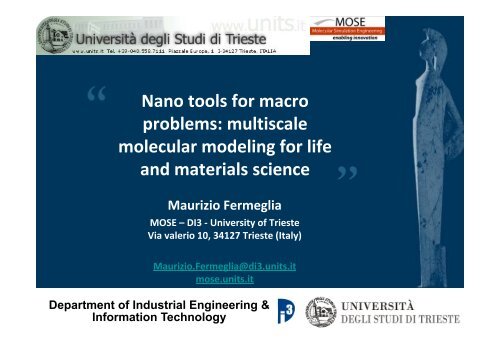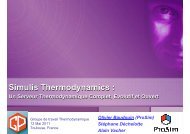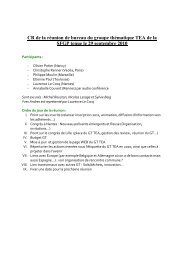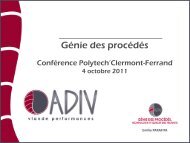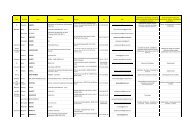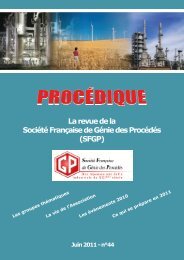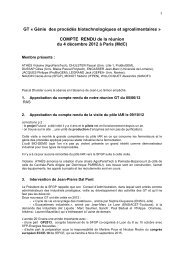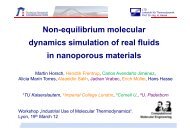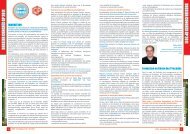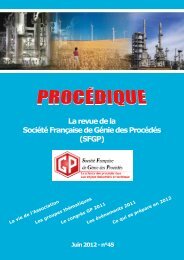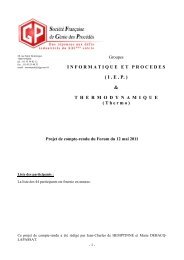Nano tools for macro problems: multiscale molecular ... - SFGP
Nano tools for macro problems: multiscale molecular ... - SFGP
Nano tools for macro problems: multiscale molecular ... - SFGP
Create successful ePaper yourself
Turn your PDF publications into a flip-book with our unique Google optimized e-Paper software.
University of Trieste<br />
<strong>Nano</strong> <strong>tools</strong> <strong>for</strong> <strong>macro</strong><br />
<strong>problems</strong>: <strong>multiscale</strong><br />
<strong>molecular</strong> modeling <strong>for</strong> life<br />
and materials science<br />
Maurizio Fermeglia<br />
MOSE –DI3 ‐ University of Trieste<br />
Via valerio 10, 34127 Trieste (Italy)<br />
Maurizio.Fermeglia@di3.units.it<br />
mose.units.it<br />
Department of Industrial Engineering &<br />
In<strong>for</strong>mation Technology
The technology vision 2020<br />
InMother 2012<br />
Lyon, 20 April 2012 - 2
Horizon2020 Structure<br />
KET<br />
InMother 2012<br />
Lyon, 20 April 2012 - 3
Introduction of new generation of products and<br />
productive processes (2000‐2020)<br />
• Timeline <strong>for</strong> beginning of industrial prototyping and nanotechnology<br />
commercialization<br />
InMother 2012<br />
Lyon, 20 April 2012 - 4
Multiscale Molecular Modeling<br />
CHARACTERISTIC TIMES<br />
years<br />
Engineering<br />
design<br />
hours<br />
minutes<br />
seconds<br />
microseconds<br />
nanoseconds<br />
Atomistic<br />
simulation<br />
(atoms)<br />
Mesoscale<br />
modeling<br />
(groups of<br />
atoms or<br />
molecules)<br />
Process<br />
simulation<br />
FEM<br />
(continuum)<br />
picoseconds<br />
femtoseconds<br />
Quantum<br />
mechanics<br />
(electrons)<br />
1Å<br />
1nm 1μm 1mm 1m<br />
CHARACTERISTIC LENGHTS<br />
InMother 2012<br />
Lyon, 20 April 2012 - 5
Many scale Molecular Modeling<br />
CHARACTERISTIC TIMES<br />
years<br />
Engineering<br />
design<br />
hours<br />
minutes<br />
seconds<br />
microseconds<br />
nanoseconds<br />
Atomistic<br />
simulation<br />
(atoms)<br />
Mesoscale<br />
modeling<br />
(groups of<br />
atoms or<br />
molecules)<br />
Process<br />
simulation<br />
FEM<br />
(continuum)<br />
picoseconds<br />
femtoseconds<br />
Quantum<br />
mechanics<br />
(electrons)<br />
1Å<br />
1nm 1μm 1mm 1m<br />
CHARACTERISTIC LENGHTS<br />
InMother 2012<br />
Lyon, 20 April 2012 - 6
Modelling and experiments<br />
InMother 2012<br />
Lyon, 20 April 2012 - 7
• Introduction<br />
Outline of talk<br />
– Multiscale Molecular Modeling<br />
• Mapping procedure<br />
– From atomistic simulation to mesoscale<br />
– From mesoscale to micro FEM<br />
• Applications to materials science<br />
– Polymer clay nanocomposites<br />
– Self assembly of nanoparticles in block copolymers<br />
• Applications to life science<br />
– Block copolymers <strong>for</strong> drug delivery<br />
• Conclusions<br />
InMother 2012<br />
Lyon, 20 April 2012 - 8
From atoms … to beads<br />
Molecular Dynamics<br />
Dissipative Particle Dynamics<br />
ForceField based calculations<br />
Soft potentials calculations<br />
F i = f (a ii , a ij , …, r c )<br />
• Polymeric materials are modeled<br />
by connecting beads by<br />
harmonic springs<br />
InMother 2012<br />
Lyon, 20 April 2012 - 9
From atoms … to beads<br />
• The parameters <strong>for</strong> Mesoscale (MesoDyn or DPD) are<br />
– the bead size and Gaussian chain architecture<br />
– the bead mobilities M,<br />
– the effective Flory‐Huggins interactions<br />
• Method 1: polymer blends, copolymers, spherical nanofillers<br />
– bead size and Gaussian chain architecture: by MD<br />
• from characteristic ratio (C) in terms of Kuhn length<br />
– mobility: by Molecular Dynamics<br />
• Bead self diffusion coefficients<br />
– FH interactions: by Molecular Dynamics<br />
• Differences in non bonded energies between bulk and isolated chain<br />
• Method 2: nanofillers of any size and shape<br />
– bead size and Gaussian chain architecture: by MD<br />
• from characteristic ratio (C) in terms of Kuhn length<br />
– mobility: by Molecular Dynamics<br />
• Bead self diffusion coefficients<br />
– Interaction parameters are determined directly from energy distribution in<br />
MD<br />
• Considering density distribution around nanofiller<br />
InMother 2012<br />
Lyon, 20 April 2012 - 10
Method 1: bead size, chain architecture<br />
• MD NPT runs on homo polymers<br />
– Monomer length<br />
– C ∞ calculation and Kuhn lenght<br />
– Chain architecture<br />
r<br />
r<br />
2<br />
max<br />
0<br />
C<br />
NL<br />
<br />
nl<br />
2<br />
<br />
NL<br />
2<br />
Rotational Isomeric State<br />
C1 C2 C3 C4 Cn<br />
MM minimization and annealing<br />
MD - NPT<br />
2 – end to end distance<br />
2 / n l 2 = C∞<br />
Change<br />
chain<br />
lenght<br />
Cinf(% )<br />
100<br />
90<br />
80<br />
70<br />
60<br />
50<br />
40<br />
30<br />
20<br />
10<br />
0<br />
0 50 100 150 200<br />
N<br />
Fermeglia, M. et al., Polymer, 47:5979‐5989 (2006)<br />
InMother 2012<br />
C∞<br />
Lyon, 20 April 2012 - 11
Method 1: F‐H interaction parameter chi<br />
• Molecular dynamics NPT and NVT runs<br />
E<br />
coh<br />
<br />
E<br />
periodic<br />
nb<br />
<br />
E<br />
isolated<br />
nb<br />
<br />
E<br />
<br />
RT<br />
mix<br />
V<br />
mon<br />
E<br />
mix<br />
<br />
1<br />
<br />
<br />
<br />
E<br />
V<br />
coh<br />
<br />
<br />
<br />
pure1<br />
<br />
2<br />
<br />
<br />
<br />
E<br />
V<br />
coh<br />
<br />
<br />
<br />
pure2<br />
<br />
<br />
<br />
E<br />
V<br />
coh<br />
<br />
<br />
<br />
mix<br />
a<br />
AB<br />
a<br />
<br />
3.271<br />
<br />
<br />
3.9<br />
<br />
AA 0. 51<br />
nDPD<br />
<br />
<br />
<br />
AB<br />
Fermeglia, M. and Pricl S., AIChE J., 2619 (45), 1999<br />
InMother 2012<br />
Lyon, 20 April 2012 - 12
Method 2: Mapping DPD parameters<br />
Single, binary, ternary<br />
energies from MD<br />
Binding energies are<br />
rescaled considering the<br />
number of contacts<br />
tot<br />
E n E n E 2<br />
sys<br />
ii ii<br />
jj jj<br />
n<br />
ij<br />
E<br />
ij<br />
Binding energies from MD<br />
(vdW + Coulomb)<br />
References DPD<br />
Interactions are selected<br />
Equal beads aij 25<br />
Define DPD beads<br />
(head, tail, …) and<br />
recalculate energies<br />
DPD matrix parameters<br />
(scaling from references)<br />
Strong repulsive beads<br />
aij >25<br />
Density profiles from MD =? Density profiles from DPD<br />
Scocchi et al., J. Phys. Chem. B,<br />
(2007), 111, 2143<br />
InMother 2012<br />
Lyon, 20 April 2012 - 13
From beads to micro FEM<br />
Dissipative Particle Dynamics<br />
Micro ‐ FEM Simulation<br />
FEM Analysis:<br />
Macroscopic<br />
properties<br />
Soft potentials calculations<br />
F i = f (a ii , a ij , …, r c )<br />
Characteristic dimension of mesoscopic<br />
system<br />
Toth R., Santese F., Pereira S.P., Romero‐Nieto D., Pricl S., Fermeglia M., Posocco, Journal of Materials Chemistry, 2012<br />
InMother 2012<br />
Lyon, 20 April 2012 - 14
From beads … to micro: fixed grid<br />
• Geometry: map cubes to Palmyra<br />
tetrahedrons<br />
• Laplace equation is solved <strong>for</strong><br />
electric conductance,<br />
diffusion and permeability<br />
• Local de<strong>for</strong>mation allow the<br />
calculation of mechanical<br />
properties<br />
Atomistic<br />
Mesoscale<br />
Fixed grid<br />
Variable grid<br />
Physical Prop.<br />
InMother 2012<br />
Lyon, 20 April 2012 - 15


